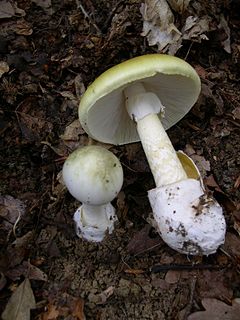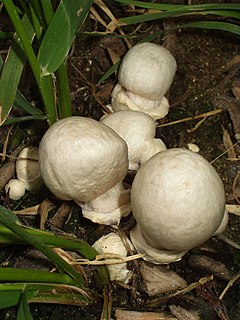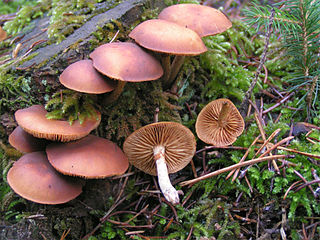Amanitin may refer to several related amatoxins:

Amanita phalloides, commonly known as the death cap or death cup, is a deadly poisonous basidiomycete fungus, one of many in the genus Amanita. Widely distributed across Europe, but now sprouting in other parts of the world, A. phalloides forms ectomycorrhizas with various broadleaved trees. In some cases, the death cap has been introduced to new regions with the cultivation of non-native species of oak, chestnut, and pine. The large fruiting bodies (mushrooms) appear in summer and autumn; the caps are generally greenish in colour with a white stipe and gills. The cap colour is variable, including white forms, and is thus not a reliable identifier.

The name destroying angel applies to several similar, closely related species of deadly all-white mushrooms in the genus Amanita. They are Amanita bisporigera and A. ocreata in eastern and western North America, and A. virosa in Europe. Another very similar species, A. verna or fool's mushroom, was first described in France.

α-Amanitin (alpha-Amanitin) is a cyclic peptide of eight amino acids. It is possibly the most deadly of all the amatoxins, toxins found in several species of the mushroom genus Amanita, one being the death cap as well as the destroying angel, a complex of similar species, principally A. virosa and A. bisporigera. It is also found in the mushrooms Galerina marginata and Conocybe filaris. The oral LD50 of amanitin is 100 μg/kg for rats.

Mushroom poisoning is poisoning resulting from the ingestion of mushrooms that contain toxic substances. Its symptoms can vary from slight gastrointestinal discomfort to death in about 10 days. Mushroom toxins are secondary metabolites produced by the fungus.

Amanita virosa, commonly known in Europe as the destroying angel or the European destroying angel amanita, is a deadly poisonous basidiomycete fungus, one of many in the genus Amanita. Occurring in Europe, A. virosa associates with various deciduous and coniferous trees. The large fruiting bodies appear in summer and autumn; the caps, stipes and gills are all white in colour.

Galerina is a genus of small brown-spore saprobic fungi, with over 300 species found throughout the world from the far north to remote Macquarie Island in the Southern Ocean. The genus is most noted for some extremely poisonous species which are occasionally confused with hallucinogenic species of Psilocybe. Species are typically small and hygrophanous, with a slender and brittle stem. They are often found growing on wood, and when on the ground have a preference for mossy habitats.
Amatoxin is the collective name of a subgroup of at least nine related toxic compounds found in three genera of poisonous mushrooms and one species of the genus Conocybe. From the amanita, the most notably is the death cap. Amatoxins are lethal in even small doses, as little as half a mushroom, including the immature 'egg' form which appears quite different from the fully-grown mushroom.

Cyclic peptides are polypeptide chains which contain a circular sequence of bonds. This can be through a connection between the amino and carboxyl ends of the peptide, for example in cyclosporin; a connection between the amino end and a side chain, for example in bacitracin; the carboxyl end and a side chain, for example in colistin; or two side chains or more complicated arrangements, for example in amanitin. Many cyclic peptides have been discovered in nature and many others have been synthesized in the laboratory. Their length ranges from just two amino acid residues to hundreds. In nature they are frequently antimicrobial or toxic; in medicine they have various applications, for example as antibiotics and immunosuppressive agents. Thin-Layer Chromatography (TLC) is a convenient method to detect cyclic peptides in crude extract from bio-mass.

Amanita verna, commonly known as the fool's mushroom, destroying angel, mushroom fool or the spring destroying angel amanita, is a deadly poisonous basidiomycete fungus, one of many in the genus Amanita. Occurring in Europe in spring, A. verna associates with various deciduous and coniferous trees. The caps, stipes and gills are all white in colour.

Galerina marginata, known colloquially as funeral bell, deadly skullcap, autumn skullcap or deadly galerina, is a species of extremely poisonous mushroom-forming fungus in the family Hymenogastraceae of the order Agaricales. It contains the same deadly amatoxins found in the death cap. Ingestion in toxic amounts causes severe liver damage with vomiting, diarrhea, hypothermia, and eventual death if not treated rapidly. About ten poisonings have been attributed to the species now grouped as G. marginata over the last century.

Amanita ocreata, commonly known as the death angel, destroying angel, angel of death or more precisely western North American destroying angel, is a deadly poisonous basidiomycete fungus, one of many in the genus Amanita. Occurring in the Pacific Northwest and California floristic provinces of North America, A. ocreata associates with oak trees. The large fruiting bodies generally appear in spring; the cap may be white or ochre and often develops a brownish centre, while the stipe, ring, gill and volva are all white.

β-Amanitin (beta-Amanitin) is a cyclic peptide comprising eight amino acids. It is part of a group of toxins called amatoxins, which can be found in several mushrooms belonging to the genus Amanita. Some examples are the death cap and members of the destroying angel complex, which includes A. virosa and A. bisporigera. Due to the presence of α-amanitin, β-amanitin, γ-amanitin and ε-amanitin these mushrooms are highly lethal to human beings.

γ-Amanitin (gamma-Amanitin) is a cyclic peptide of eight amino acids. It is an amatoxin, a group of toxins isolated from and found in several members of the mushroom genus Amanita, one being the death cap as well as the destroying angel, a complex of similar species, principally A. virosa and A. bisporigera. The compound is highly toxic, inhibits RNA polymerase II, disrupts synthesis of mRNA, and can be fatal.

Lepiota brunneoincarnata, also known as the deadly dapperling, is a gilled mushroom of the genus Lepiota in the order Agaricales. Widely distributed in Europe and temperate regions of Asia as far east as China, it grows in grassy areas such as fields, parks and gardens, and is often mistaken for edible mushrooms. The mushroom has a brown scaled cap up to 4 cm wide with a pinkish brown stem and white gills. It is highly toxic, with several deaths having been recorded as it resembles the edible grey knight and fairy ring champignon.
Chemical tests in mushroom identification are methods that aid in determining the variety of some fungi. The most useful tests are Melzer's reagent and potassium hydroxide.

ε-Amanitin (epsilon-Amanitin) is a cyclic peptide. It is an amatoxin, all of which are found in several members of the mushroom genus Amanita. The oral LD50 of ε-amanitin is approximately 0.1 mg/kg.

Amaninamide is a cyclic peptide. It is one of the amatoxins, all of which are found in several members of the mushroom genera Amanita, Lepiota and Galerina. It differs from alpha-amanitin in lacking the hydroxyl group on tryptophan. This alters its UV absorption spectrum but not its toxicity.

Galerina sulciceps is a dangerously toxic species of fungus in the family Strophariaceae, of the order Agaricales. It is distributed in tropical Indonesia and India, but has reportedly been found fruiting in European greenhouses on occasion. More toxic than the deathcap, G. sulciceps has been shown to contain the toxins alpha- (α-), beta- (β-) and gamma- (γ-) amanitin; a series of poisonings in Indonesia in the 1930s resulted in 14 deaths from the consumption of this species. It has a typical "little brown mushroom" appearance, with few obvious external characteristics to help distinguish it from many other similar nondescript brown species. The fruit bodies of the fungus are tawny to ochre, deepening to reddish-brown at the base of the stem. The gills are well-separated, and there is no ring present on the stem.

Amanita bisporigera is a deadly poisonous species of fungus in the family Amanitaceae. It is commonly known as the eastern destroying angel amanita, the eastern North American destroying angel or just as the destroying angel, although the fungus shares this latter name with three other lethal white Amanita species, A. ocreata, A. verna and A. virosa. The fruit bodies are found on the ground in mixed coniferous and deciduous forests of eastern North America south to Mexico, but are rare in western North America; the fungus has also been found in pine plantations in Colombia. The mushroom has a smooth white cap that can reach up to 10 cm (4 in) across, and a stipe, up to 14 cm (5.5 in) long by 1.8 cm (0.7 in) thick, that has a delicate white skirt-like ring near the top. The bulbous stipe base is covered with a membranous sac-like volva. The white gills are free from attachment to the stalk and crowded closely together. As the species name suggests, A. bisporigera typically bears two spores on the basidia, although this characteristic is not as immutable as was once thought.

Amanita exitialis, also known as the Guangzhou destroying angel, is a mushroom of the large genus Amanita. It is distributed in eastern Asia, and probably also in India where it has been misidentified as A. verna. Deadly poisonous, it is a member of section Phalloideae and related to the death cap A. phalloides. The fruit bodies (mushrooms) are white, small to medium-sized with caps up to 7 cm (2.8 in) in diameter, a somewhat friable ring and a firm volva. Unlike most agaric mushrooms which typically have four-spored basidia, the basidia of A. exitialis are almost entirely two-spored. Eight people were fatally poisoned in China after consuming the mushroom in 2000, and another 20 have been fatally poisoned since that incident. Molecular analysis shows that the species has a close phylogenetic relationship with three other toxic white Amanitas: A. subjunquillea var. alba, A. virosa and A. bisporigera.